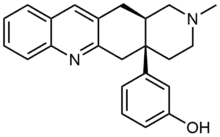TAN-67
TAN-67 (SB-205,607) is an opioid drug used in scientific research that acts as a potent and selective δ-opioid agonist,[1] selective for the δ1 subtype.[2] It has analgesic properties[3][4] and induces dopamine release in nucleus accumbens.[5] It also protects both heart and brain tissue from hypoxic tissue damage through multiple mechanisms involving among others an interaction between δ receptors and mitochondrial K(ATP) channels.[6][7][8][9][10]
 | |
| Identifiers | |
|---|---|
| |
| CAS Number | |
| PubChem CID | |
| ChemSpider | |
| KEGG | |
| ChEMBL | |
| Chemical and physical data | |
| Formula | C23H24N2O |
| Molar mass | 344.458 g·mol−1 |
| 3D model (JSmol) | |
| |
| |
| (verify) | |
References
- Fujii H, Kawai K, Kawamura K, Mizusuna A, Onoda Y, Murachi M, et al. (2001). "Synthesis of optically active TAN-67, a highly selective delta opioid receptor agonist, and investigation of its pharmacological properties". Drug Design and Discovery. 17 (4): 325–30. PMID 11765135.
- Nagase H, Kawai K, Hayakawa J, Wakita H, Mizusuna A, Matsuura H, et al. (November 1998). "Rational drug design and synthesis of a highly selective nonpeptide delta-opioid agonist, (4aS*,12aR*)-4a-(3-hydroxyphenyl)-2-methyl- 1,2,3,4,4a,5,12,12a-octahydropyrido[3,4-b]acridine (TAN-67)". Chemical & Pharmaceutical Bulletin. 46 (11): 1695–702. doi:10.1248/cpb.46.1695. PMID 9845952.
- Yajima Y, Narita M, Tsuda M, Imai S, Kamei J, Nagase H, Suzuki T (December 2000). "Modulation of NMDA- and (+)TAN-67-induced nociception by GABA(B) receptors in the mouse spinal cord". Life Sciences. 68 (6): 719–25. doi:10.1016/s0024-3205(00)00975-9. PMID 11205886.
- Nagase H, Yajima Y, Fujii H, Kawamura K, Narita M, Kamei J, Suzuki T (April 2001). "The pharmacological profile of delta opioid receptor ligands, (+) and (-) TAN-67 on pain modulation". Life Sciences. 68 (19–20): 2227–31. doi:10.1016/s0024-3205(01)01010-4. PMID 11358331.
- Fusa K, Takahashi I, Watanabe S, Aono Y, Ikeda H, Saigusa T, et al. (2005). "The non-peptidic delta opioid receptor agonist TAN-67 enhances dopamine efflux in the nucleus accumbens of freely moving rats via a mechanism that involves both glutamate and free radicals". Neuroscience. 130 (3): 745–55. doi:10.1016/j.neuroscience.2004.10.016. PMID 15590157.
- Fryer RM, Hsu AK, Nagase H, Gross GJ (August 2000). "Opioid-induced cardioprotection against myocardial infarction and arrhythmias: mitochondrial versus sarcolemmal ATP-sensitive potassium channels". The Journal of Pharmacology and Experimental Therapeutics. 294 (2): 451–7. PMID 10900218.
- Huh J, Gross GJ, Nagase H, Liang BT (January 2001). "Protection of cardiac myocytes via delta(1)-opioid receptors, protein kinase C, and mitochondrial K(ATP) channels". American Journal of Physiology. Heart and Circulatory Physiology. 280 (1): H377-83. doi:10.1152/ajpheart.2001.280.1.H377. PMID 11123254.
- Patel HH, Ludwig LM, Fryer RM, Hsu AK, Warltier DC, Gross GJ (September 2002). "Delta opioid agonists and volatile anesthetics facilitate cardioprotection via potentiation of K(ATP) channel opening". FASEB Journal. 16 (11): 1468–70. doi:10.1096/fj.02-0170fje. PMID 12205051.
- Maslov LN, Platonov AA, Lasukova TV, Lishmanov I, Oeltgen P, Nagase H, et al. (2006). "[Delta-opioid receptor activation prevents appearance of irreversible damages of cardiomyocytes and exacerbates myocardial contractility dysfunction during ischemia and reperfusion]". Patologicheskaia Fiziologiia I Eksperimental'naia Terapiia (4): 13–7. PMID 17300082.
- Tian XS, Zhou F, Yang R, Xia Y, Wu GC, Guo JC (August 2008). "[Effects of intracerebroventricular injection of delta-opioid receptor agonist TAN-67 or antagonist naltrindole on acute cerebral ischemia in rat]". Sheng Li Xue Bao. 60 (4): 475–84. PMID 18690389.
This article is issued from Wikipedia. The text is licensed under Creative Commons - Attribution - Sharealike. Additional terms may apply for the media files.